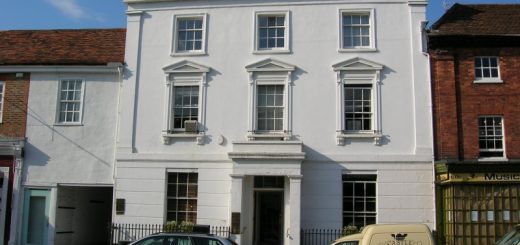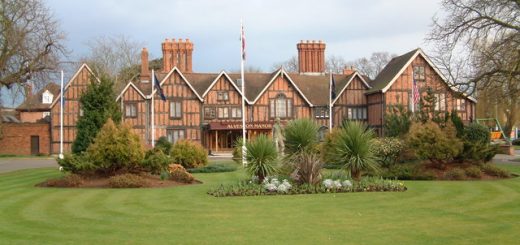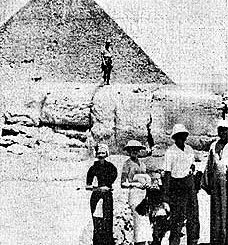Donald Kent “Deke” Slayton & John Wayne Airport
On 13 June 1993 in the skies above John Wayne Airport in Orange County a small red distinctive racing aircraft identified as belonging to astronaut Donald Slayton triggered automatic noise monitoring systems which led him being sent a noise violation warning letter. However, the aircraft in question was in a museum at the time of the alleged disturbance and Donald Kent “Deke” Slayton (March 1, 1924 – June 13, 1993) had passed away five and a half hours earlier.
In part of his article entitled Ghosts in the machine – Tales of haunted hangars and phantom pilots , Guy Norris from Flight International describes the reported experience.
I didn’t keep a diary in 1993, so I will never know how close I came to witnessing the events that reportedly happened just a few miles away on 13 June that year. It was Sunday morning and I was at home in Orange County, California, while most of my Flight International colleagues were in Paris covering the air show.
What I, and the rest of the world, did not yet know was that Donald “Deke” Slayton, one of the original Mercury “Seven” astronauts and a true test pioneer of The Right Stuff fame, had just died at his home 2,225km (1,200nm) away in Houston, Texas. Slayton, who succumbed to a brain tumour, died at 03:22 local time, with his wife Bobbie and daughter Stacey at his bedside.
 Although one of the select group picked to be the USA’s first astronauts, Slayton was at first prevented from going into space by a heart problem, and it was not until he was cleared for flight in the 1970s that he finally made it into orbit as the docking module pilot of the 1975 Apollo-Soyuz project. Having celebrated his 51st birthday four months before the docking mission with the Soviet cosmonauts, he was then the oldest man to fly into space.
Although one of the select group picked to be the USA’s first astronauts, Slayton was at first prevented from going into space by a heart problem, and it was not until he was cleared for flight in the 1970s that he finally made it into orbit as the docking module pilot of the 1975 Apollo-Soyuz project. Having celebrated his 51st birthday four months before the docking mission with the Soviet cosmonauts, he was then the oldest man to fly into space.
Back on Earth, Slayton later led the Shuttle approach and landing test programme before retiring from NASA in 1982. But retirement could not keep this ex-astronaut, Second World War bomber pilot and test pilot out of the air for long, and he developed an enthusiasm for the adrenalin-charged world of Formula One air racing. His chosen mount was a bright red, Art Williams-built 19ft (5.8m)-span monoplane dubbed “Stinger”, with a 100hp (75kW) Continental 0-200 piston and the number “21” on the fuselage in black. Formerly flown to 18 US racing victories – including two national championships – by ace racer John Paul Jones, the Stinger was finally donated in the early 1990s by Slayton to an air racing museum in Nevada, never to fly again… or was it?
Orange County’s John Wayne airport – at the centre of this strange tale – is tightly ringed by urban development and is one of the most noise-sensitive airfields anywhere in the world. Surrounded by a battery of 10 noise-monitoring stations (NMS), the airport’s noise abatement office maintains a careful curfew that prevents any airliners from taking off before 07:00 Mondays to Saturdays, and 08:00 on Sundays. These same hours also mark the noise limitations for business and general aviation aircraft, which can operate for periods into the night as long as certain noise levels are not exceeded.
At 07:57 on 13 June 1993, while the curfew was still in place and commercial airliners were waiting impatiently for take-off clearance, a small red racing aircraft apparently took off, performed “various flight manoeuvres” according to reports, and immediately triggered the sensitive noise-monitoring systems into action. NMS1, 0.75km from the runway localiser, recorded 90.4dBA, against a limit of 86.8dBA. NMS2, south of the departure path from runways 19 left and right, spiked at 90.9dBA (versus 86.9dBA) and NMS3, 1.3km away, registered 3.5dBA beyond the limit. The aircraft was then seen to continue in a slow climb to the west, outbound, and out of sight over the nearby Pacific.
It is unclear whether air traffic control tried to make voice contact with the mystery aircraft, but what is known is that several witnesses reported the noisy, high-speed fixed-propeller aircraft to the airport’s Noise Abatement Office. All reports, presumably linking the clearly visible “21” identifier with the unusual lines of the F1 racer, identified it as the US Federal Aviation Administration-registered N21X.
A notice of violation of the airport’s General Aviation Noise Ordnances Section 2-1-30 was sent by certified mail on 28 June 1993 to the Houston address of the aircraft’s registered owner, Donald Slayton. Here it was picked up by Slayton’s astonished widow, who read: “As an initial violation, this letter is intended as a warning, to seek your voluntary compliance with the Noise Ordinance – absent any additional violation, no further referral of this matter will be made.”
Bobbie Slayton told the FAA that not only had her husband died about five and a half hours (including local time differences between Texas and California) before the alleged incident, but that N21X was, at the time, stored in a museum several hundred miles away. Edward Maloney, who received the aircraft into his museum collection from Slayton all those years ago, says: “We’ve never flown it at all since Deke gave it to us. He was the last one ever to fly it.” Contrary to other reports, Maloney says the engine has never been removed from the aircraft which, in the mid-1990s, was relocated to his Planes Of Fame museum in Chino, California, where it resides to this day.
Although Maloney believes the ghost flight incident is “someone having pipedreams”, there appears to be more than the usual circumstantial evidence often attributed to paranormal occurrences. Kay Bender, executive director of the Deke Slayton Memorial Space and Bicycle Museum in Sparta, Wisconsin – close to the farm where Slayton was born in 1924 – provided Flight International with a copy of the violation notice and says: “We have never questioned its authenticity.” Although a few enquiries about the incident crop up from time to time, Bender says most visitors are interested in the stories about Slayton’s proven lifetime achievements in space and in the air.
Beyond that, JWA’s Noise Abatement Office changed its record-keeping process in the late 1990s and enquiries to the control tower revealed that, in common with most FAA sites, the strips recording movements from and to the airport are stored for only six months. So, like so many other apparent sightings and unusual events, Slayton’s reported final flight remains a tantalising enigma.
But if it was a prank, and someone risked the ire of the FAA to fake Slayton’s aircraft, the timing was “highly unusual”, says Loyd Auerbach, the San Francisco-based director of the Office of Paranormal Investigations. “Surely, the best time to pull something like this would have been while Slayton was still alive. At the time we know that only Bobbie, their daughter and the doctor knew he was dead.” The Formula One type aircraft is also highly unusual at John Wayne, where most of the resident high-performance sports aircraft are well known and easily recognised.
Also worth noting is a reported UFO sighting made by Donald Slayton over Prescott whilst doing a maintenance flight in an F-51.




Recent Comments